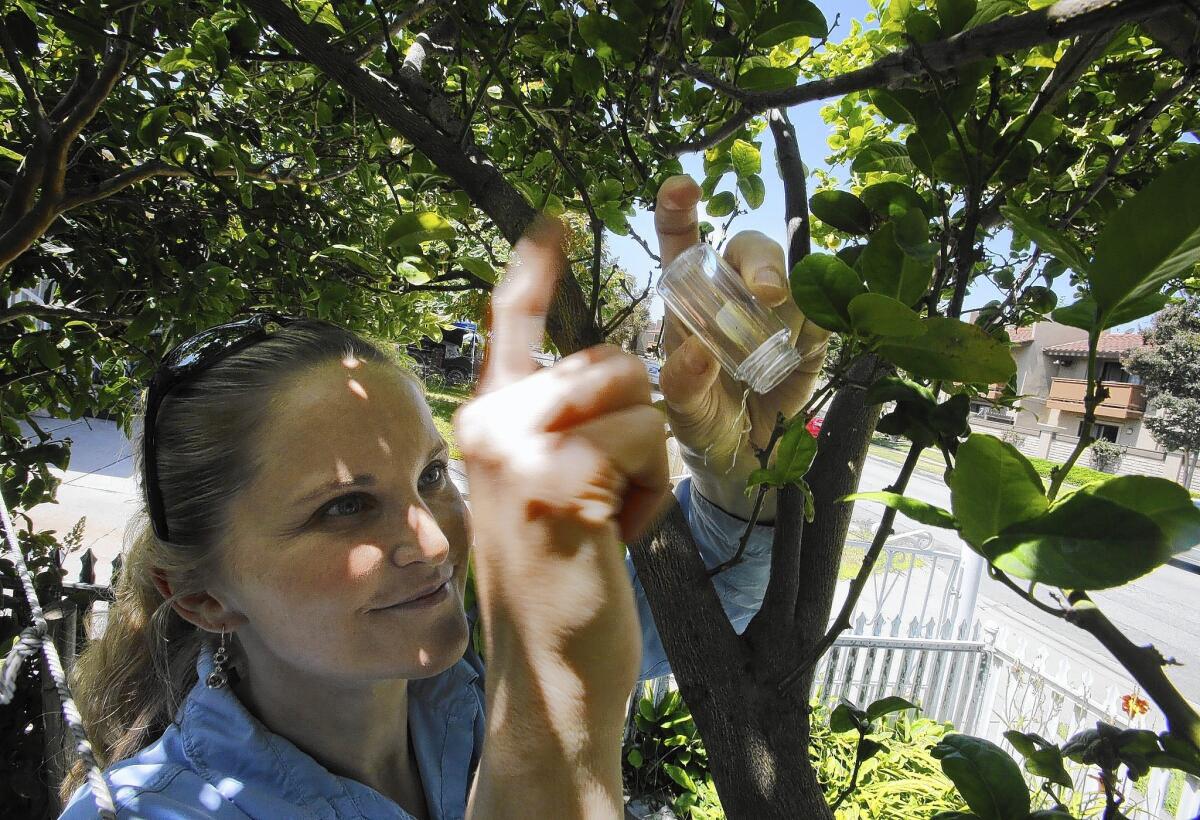USDA expanding use of wasp to fight citrus greening in California

- Share via
The fight against a disease threatening California citrus got a boost Tuesday when the U.S. Department of Agriculture said it would expand efforts to breed and release a tiny parasitic wasp, a natural enemy of a pest that spreads the incurable ailment.
In recent months, federal agriculture officials have coordinated a multi-agency effort to contain the spread of huanglongbing, also known as citrus greening, a disease that has infected and killed thousands of citrus trees in Florida and is now threatening California’s $2-billion citrus industry.
Huanglongbing is spread by the Asian citrus psyllid, a tiny pest that has proliferated rapidly across the U.S. Quarantines cover parts or all of at least 14 states and U.S. territories.
Florida researchers first began releasing the wasp imported from Vietnam in limited quantities in 1999. UC Riverside researchers started releasing a strain imported from Pakistan in the Los Angeles urban area in 2011, in an effort to provide a buffer for the commercial citrus growing areas further north.
Known by its scientific name, Tamarixia radiata, the wasp is half the size of a chocolate sprinkle but an effective killer of psyllids. Officials have said the wasp poses no threat to the environment, humans or pets.
The USDA said it would set aside $1.5 million to scale up breeding and release efforts in three states: California, Texas and Florida. An additional $125 million appropriated by Congress will be spent over the next five years to fund research into other methods to contain the spread of the disease.
“This is a serious threat to the citrus industry in California,” Agriculture Secretary Tom Vilsack said in an interview. The breeding and release program has been expanded “so we can do a better job of containing and ultimately eliminating this disease.”
“The goal here is to invest in additional research and to use effectively the research we’ve already conducted in a targeted and effective way,” Vilsack added.
The USDA has signaled that eradicating the pest and researching methods to eliminate the disease are top priorities. It created the Huanglongbing Multi-Agency Coordination Group, which is led by the USDA’s Animal and Plant Health Inspection Service.
This group was created “to leverage resources and provide funding to support the scale-up of the promising tools,” said Mary Palm, the plant pathologist who leads the group.
Among some of the promising methods to combat the spread of the disease is thermal therapy, which involves heating the trees to treat huanglongbing. Scientists are also exploring ways to enrich the soil trees grow in to make them less susceptible to disease.
“No one group can do it alone, but if we all work together, we can move it forward in a much more orderly, coordinated and strategic manner,” Palm said.
In California, agriculture officials have enacted quarantines covering all or parts of 12 counties, including Santa Barbara, Ventura, Los Angeles and San Bernardino. Further north, parts of Tulare and Fresno counties were quarantined, which restricts the movement of citrus trees and requires labeling of citrus nursery stock.
Recent discoveries of the psyllid in Central California raise the fear that the pest is taking hold in prime citrus-growing areas, where it could threaten the state’s massive industry, which accounts for about 80% of U.S. fresh market citrus production. Florida’s citrus is primarily processed for juice.
Since 2010, California growers have spent about $15 million yearly to fight the psyllid. Much of that money goes toward massive detection and awareness efforts.
The psyllids themselves don’t kill citrus trees. They’re merely the agent that spreads huanglongbing. An infected psyllid acts much like a dirty syringe, flying from tree to tree, feeding and depositing a bacterium each time it unfurls its needle-like mouth, much like a mosquito.
That’s why reducing the psyllid population is vital to making headway in preventing the spread of the disease.
“I think it’s an excellent idea,” said Mark Hoddle, a UC Riverside researcher who has been releasing a strain of the wasp that he and his wife, Christina, imported from the Punjab region of Pakistan, which has a similar climate to California.
Hoddle said the expansion would allow the California Department of Food and Agriculture to ramp up the scale of the breeding program.
The efforts by the Hoddles and a small team they’ve trained has been on a smaller scale, Mark said. “The process can be slow and tedious,” he said. “We have since transitioned the mass production of wasps to CDFA and they are working with financial support from the USDA to mass rear and release the parasites.”
State agriculture researchers are currently producing about 10,000 wasps a week and aim to produce about 1 million a year, Hoddle said.
Twitter: @rljourno
More to Read
Inside the business of entertainment
The Wide Shot brings you news, analysis and insights on everything from streaming wars to production — and what it all means for the future.
You may occasionally receive promotional content from the Los Angeles Times.











